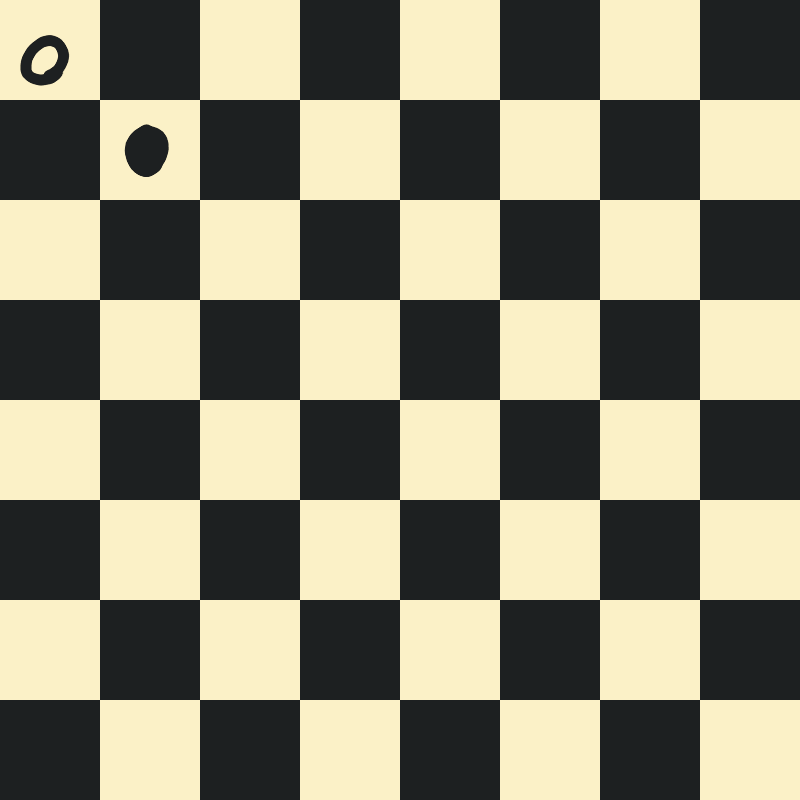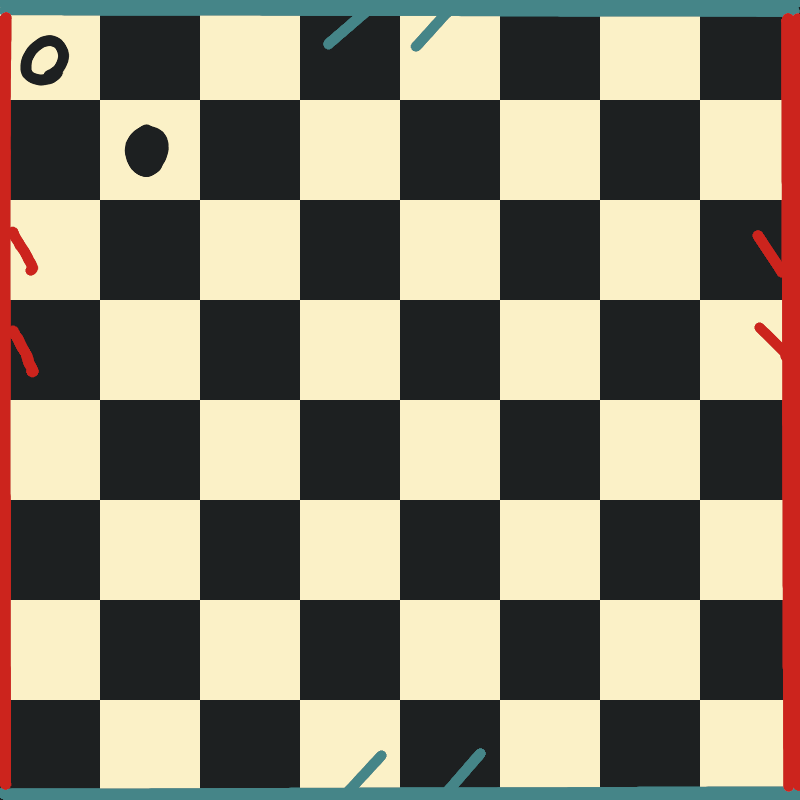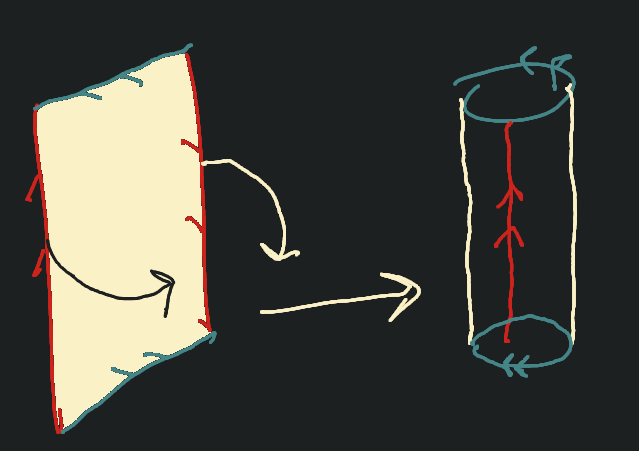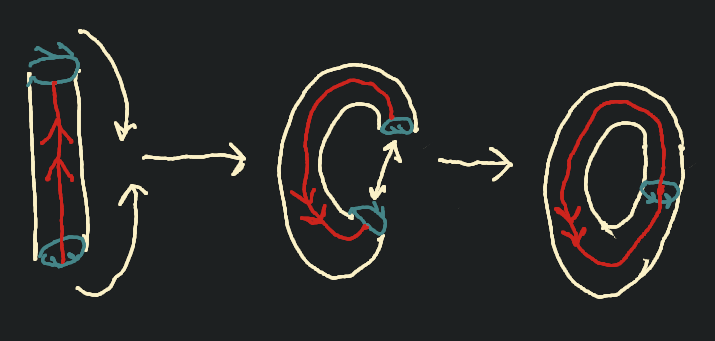Chesskers!! The grand unification of the checkered board
+----------------------+
8 |r n b q k b n r|
7 |p p p p p p p|
6 | |
5 | p |
4 | P |
3 | |
2 |P P P P P P P|
1 |R N B Q K B N R|
+----------------------+
a b c d e f g h
Hey everyone, I just remembered my github password, so here we are. A small disclaimer before we get into this: I am not good at chess, and am also not good at chesskers. I'm here to give you a rundown of how to play and some very basic theory. I just thought it would be fun to get this amazing variant out of our chess club.
Chess is a roguelike bullet hell made by a collaboration between Persian, Arab, and European gamedevs. Considered a classic, chess has few derivatives, with notable examples being FPS Chess and the Touhou Project.
Chess is also a modding hotbed, with popular mods being Fischer random, atomic, and 5D multiversal with time travel. The mod I'm going to present today is homemade; straight out of our chess club, it's chesskers.
enter the gungeon is more similar to chess than I thoughtEnter Chesskers
Chesskers is a mod integrating the famous trans-coming-out story game checkers with the previously-discussed chess. Though placing more emphasis on chess, its inspirations are clear.
Ok, dropping the gamedev narrative, I learned this variant when first entering chess club, and I figured contributing to its diffusion out of chess club would be great since I find it super fun.
Rules
Relative to the base game, pieces/pawns (I'm just going to call them "pieces" for the sake of brevity if that's okay with you) behave the same until they take another of their kin. This means that, if you know chess, jumping straight into things with a friend shouldn't be difficult. The fun, however, begins upon taking a piece.
First of all, the game doesn't end on checkmate. The concept of check and checkmate don't enforce what moves you make (if your king is presumably in danger, you don't have to move it out of the way). The game ends when one of the kings fall or if both players agree to a draw.
Secondly, any piece can be taken by any other piece, regardless of homochromaticity. This at first look doesn't make sense, but the usage of other pieces as "scaffolding" is a fundamental strategy used by chesskers players.
The checkers of it all
On taking a piece, the "kers" in chesskers shows itself. Take the following board
+----------------------+
8 |r n b q k b n r|
7 |p p p p p p p|
6 | |
5 | p |
4 | P |
3 | |
2 |P P P P P P P|
1 |R N B Q K B N R|
+----------------------+
a b c d e f g h
Taking on d5, which would normally land the white pawn on d5, now causes the pawn to "jump" to c6, as shown below
+----------------------+
8 |r n b q k b n r|
7 |p p p p p p p|
6 | P<-jumped! |
5 | x<-skipped! |
4 | o<-hopped!|
3 | |
2 |P P P P P P P|
1 |R N B Q K B N R|
+----------------------+
a b c d e f g h
(tangent) What was illustrated in the notation above is called Universal Chesskers Notation (UCN) (by me since I made it lol). UCN acts nearly identical to chess' coordinate notation, with the source and capture squares (the first 2) being separated from the final destination square by a lowercase 't' (this notation acts identical to coordinate notation otherwise). You can take a look at this wikipedia article if you want to find out more about different types of chess notation. Chesskers also has a more algebraic style of notation, named Chesskers Notation (CN), for more casual environments. The above move in CN would be 1.e4 d5 2.exd5tc6
Upon taking a piece, your warrior can choose to continue on its blood-soaked path if one is available. Let's see this completely hypothetical scenario:
+----------------------+
8 |P |
7 | |
6 | P |
5 | |
4 | P |
3 | |
2 | P |
1 | p|
+----------------------+
a b c d e f g h
Like previously, the black pawn on h1 cn take on g2 and move to f3. But, much like in checkers, it can choose to take the next pawn in the sequence.
+----------------------+
8 |x |
7 | |
6 | x |
5 | |
4 | x |
3 | |
2 | x |
1 | teleported?-->p|
+----------------------+
a b c d e f g h
(Before explaining things, the way we indicate taking multiple pieces in UCN is by separating each move in the sequence with the '|' chacter)
You might've noticed that the taking of the last pawn on a8 led to the h1 pawn ending up right back where it started. This is because of the last major rule introduced to chesskers: the board is a torus.
This means that if a piece jumps over another piece on an edge, it will hop over to the next edge as if the chess board was a torus. There are 2 main exceptions to this rule:
- You can't hop over your "closet edge" (row 1 or 8 depending on if you're white or black).
- You can't hop over more than 1 edge in a given sequence.
The instant that you hop over an edge, the move sequence ends and the turn transfers. The way I like to think about this is imagining the torus being sectioned off by a fence, where you can only jump over each fence by using another piece as leverage (think mario sacrificing yoshi).
Topological Detour: why is the chesskers board a torus?
To understand why the chesskers board is a torus, a topological detour is warranted.
if this is alr clear to you, feel free to skip this section, it won't cover any extra rules
The chesskers board "loops" around, meaning that when the black pawn takes on a8, it'll end up back on h1. This means that the opposite edges of the chesskers board are connected, which we can represent by coloring each connected edge the same color:

To show the full shape of this board without lines of connections (e.g. actual connections), we need to extend it into 3D space.
Let's connect the red edges first. We can do this by folding the chesskers board outward. This creates a cylinder with the blue edges represented by circles, as shown in the poor illustration below:

Now that we have the red edges connected, let's connect the blue edges by molding the cylinder and joining the ends together:

The shape that we see form out of this construction is a torus! This isn't a surprise for those who know a little bit of topology, as these types of shapes tend to show up when spatially representing spaces that loop around like this.
Likewise, this was some very basic, non-mathy topology (I haven't even taken the class yet), but I figured this fun little detour would help illustrate this idea of jumping across board edges.
time to take a sip of my chesskers coffee mugIndividual Pieces
Ok, back to chesskers. Each piece's jumping behavior when taking a piece is fairly self-explanatory, but there are a few kinks that warrant a more detailed investigation.
Pawns
As demonstrated previously, pawns behave identical to a checkers piece when taking. They can move in both of the forward diagonals when taking. We see this below:
+----------------------+
8 | p |
7 | |
6 | p |
5 | |
4 | p |
3 | P |
2 | |
1 | |
+----------------------+
a b c d e f g h
+----------------------+
8 | x |
7 | o<-up here |
6 | x |
5 | o<-to here |
4 | x |
3 | o<-from here |
2 | |
1 | P<-back down here |
+----------------------+
a b c d e f g h
En Passant
En passant works as it would in regular chess, with the taking rules of a pawn replaced with the chesskers version:
+----------------------+
8 |r n b q k b n r|
7 |p p o p p p p|
6 | |
5 | p p P |
4 | |
3 | |
2 |P P P P P P P|
1 |R N B Q K B N R|
+----------------------+
a b c d e f g h
+----------------------+
8 |r n b q k b n r|
7 |p p P p p p p|
6 | |
5 | p x o<-jumped!|
4 | |
3 | |
2 |P P P P P P P|
1 |R N B Q K B N R|
+----------------------+
a b c d e f g h
En passant can only be played in the first jump (e.g. it can't be in a position other than the first in a sequence of pawn moves).
Bishops
Like all other pieces, bishops move normally until they take a piece. Once a bishop takes a piece, they behave identical to pawns (e.g. they can take in both advancing diagonal directions):
+----------------------+
8 | |
7 | p |
6 | |
5 | p |
4 | |
3 | |
2 | |
1 |B |
+----------------------+
a b c d e f g h
+----------------------+
8 | B |
7 | x |
6 | |
5 | x |
4 | |
3 | |
2 | |
1 |o<-bishop was here |
+----------------------+
a b c d e f g h
Rooks
Rooks can only continue their war path in the direction which they were travelling when they took (e.g. they can only hop horizontally if they intially moved horizontally)
+----------------------+
8 | |
7 | p |
6 | |
5 | p |
4 | |
3 | |
2 | |
1 | R |
+----------------------+
a b c d e f g h
+----------------------+
8 | R |
7 | x |
6 | |
5 | x |
4 | |
3 | you get the idea |
2 | |
1 | o |
+----------------------+
a b c d e f g h
+----------------------+
8 | |
7 | p |
6 | |
5 | p |
4 | |
3 | |
2 | |
1 |B |
+----------------------+
a b c d e f g h
+----------------------+
8 | B |
7 | x |
6 | |
5 | x |
4 | |
3 | |
2 | |
1 |o<-bishop was here |
+----------------------+
a b c d e f g h
Queens
Queens are a combination of rooks and bishops. This means that the queen's taking behavior depends on its angle of impact. If the queen takes like the bishop, then it can combo together hops as if it was a bishop; if it takes like the rook, then the same goes as if it was a rook.
To see a demonstration, just look at the previous 2 entries.
Kings
Kings are just queens with much more restricted movement. As such, their taking behavior is identical to queens.
Knights
Here's where things get interesting. The knight is arguably the strongest of the pieces in chesskers, mainly due to the large distances that it can travel. Here are the main rules when the knight takes a piece:
1) On taking a piece, knights can jump to the two squares that take it farther away from its original destination:
+----------------------+
8 | |
7 | |
6 | |
5 | p |
4 | |
3 | N |
2 | |
1 | |
+----------------------+
a b c d e f g h
+----------------------+
8 | |
7 | |
6 | N<-or here |
5 |here->N x |
4 | |
3 | o |
2 | |
1 | |
+----------------------+
a b c d e f g h
2) After landing, the knight can move as it normally would in all 4 directions if it can take a piece in that direction. To demonstrate this, recall the first chess board shown:
+----------------------+
8 |r n b q k b n r|
7 |p p p p p p p|
6 | |
5 | p |
4 | P |
3 | |
2 |P P P P P P P|
1 |R N B Q K B N R|
+----------------------+
a b c d e f g h
You might wonder why c5 is noted as a blunder when the Sicilian is one of the most popular defenses in chess. Well, in chesskers, 1. e4 c5 is considered the "Sicilian dumb" because of the following move:
+----------------------+
8 |r x b q k b n r|
7 |p p p p p p p|
6 | o |
5 | x |
4 | P |
3 | o |
2 |P P P x P P P|
1 |R N B Q K B N R|
+----------------------+
a b c d e f g h
These kinds of strings of moves are the bread and butter of chesskers. The game is essentially a test of who can juggle more information about a chesskers board in their head.
Some Theory
I think it's important to disclaim here that I am not good at neither chess nor chesskers. On top of this, current midgame and endgame theory are relatively underdeveloped (especially considering that there are about 5 or so active players).
Regardless, a lot of chesskers theory is built around the idea of scaffolding, which is the concept of using lesser pieces (mostly pawns) as leverage for (mostly) knights to hop around. By placing pawns in certain spots, you can create a mine field that your enemy has to pay a lot of attention to. Here's an example:
+----------------------+
8 |r n b q k n r|
7 |p p p p p p p|
6 | p |
5 | P |
4 | P |
3 | N N |
2 |P P Q P P P|
1 |R B R K |
+----------------------+
a b c d e f g h
Black has just moved to d6, putting pressure on the seemingly over-extended pawn. What black doesn't realize is that they've just blundered their queen. Using the e5 pawn as scaffolding, the knight can now take the queen and land safely on the now-vacant d1 space:
+----------------------+
8 |r n b x k n r|
7 |p p p p p p p|
6 | p o<-plop |
5 | x |
4 | P |
3 | N o |
2 |P P Q P P P|
1 |R B N R K |
+----------------------+
a b c d e f g h
This is a simple example of scaffolding, but communicates the main idea pretty well. You want to use your pawns as resources to capture some valuable pieces.
Evaluations
Because knights are significantly buffed in this variant, the evaluations for each piece is changed around:
- pawns: 1 (still the base with which everything else is evaluated)
- knights: 7 (the most powerful piece, with other pieces being buffed more evenly and this piece being buffed to the moon)
- bishops: 4 (slight buff previously that makes it more powerful than it's former iteration relative to the pawn)
- rooks: 4 (worth the same as a bishop due to both not benefitting as much from the movement increase as other pieces)
- queens: 6 (more powerful than bishops and rooks, but not as powerful as the knight)
We haven't worked on the engine in a bit, but I'm going to tune this as I work more on it. I'll update this list and provide a current evaluation list on the projects page of this website if I ever get around to doing that.
Conclusion
I may make a followup post about openings and expanding more on theory, but this post is getting long and my motivation is waning, so I figure that ending it here would be best.
Currently we have a semi-complete python build of the game, and an incomplete commonlisp build of the game (with a faster engine). Both of the engines built in only implement search-and-evaluate
I invite anybody who knows a sliver about chess programming to try and make an evaluation algorithm and implementation of the game themselves, super excited to see what anyone would come up with:)
Credits
- Debangshu: one of the founders of chesskers and co-developer of the python build of chesskers, also started the whole project by getting us together:)
- Sam: co-developer of the python build of chesskers (also ported the whole thing to commonlisp for the sake of engine speed lmao)
- Marshall, Cadyn, Callum: I can't reach out to them rn to ask how to credit them so I'll update that whenever I can. The other 3 developers of the game of chesskers





